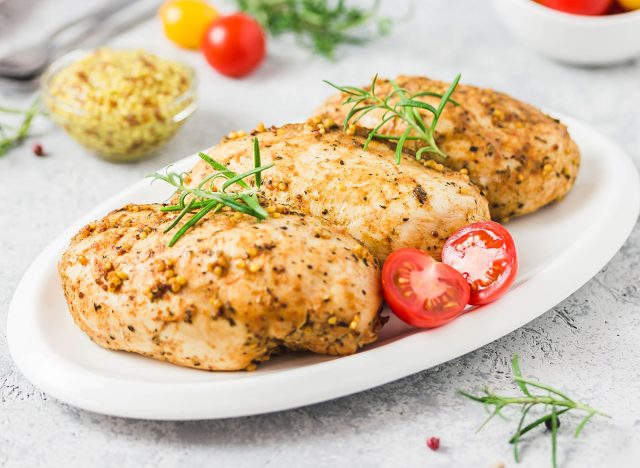
Looking to melt your middle? Don’t worry, it’s a lot easier to do than you think. All you have to do is incorporate these nine food groups, each of which helps to fight inflammation, boost metabolism, and—most important of all—turn off your fat genes and reverse your body’s tendency to store fat. These best foods to melt belly fat are designed to provide protein, fiber, and healthy fats at every meal to help boost metabolism and fight hunger. They’ll maximize your levels of macronutrients to shut down your genetic fat-storage mechanisms, while also minimizing excess sugars, refined carbohydrates, and additives that are known to aggravate the stomach and lead to inflammation and weight gain.
The result will be not only fast, easy weight loss but an almost immediate sense of energy, a leaner midsection, and a lighter body. Read on for the nine best foods that melt stubborn belly fat, and for more tips on how to eat more healthily, be sure to check out our list of 30 Cooking Tricks They Only Teach You in Culinary School.
Eggs

Eggs are the single best dietary source of the B vitamin choline, which is an essential nutrient used in the construction of all the body’s cell membranes. Two eggs will give you half your day’s worth; only beef liver has more. And believe us, starting your day with a slab of beef liver does not make for a great morning.
But as more and more research is done into the mechanisms of fat genes, the value of eggs has only grown. Choline deficiency is linked directly to the genes that cause visceral fat accumulation, particularly in the liver. One of the reasons heavy drinkers develop fatty liver is that alcohol undercuts the body’s ability to process choline.
Yet, according to the 2005 National Health and Nutrition Examination Survey, only a small percentage of all Americans eat daily diets that meet the U.S. Institute of Medicine’s Adequate Intake of 425 milligrams for women and 550 milligrams for men. Start your day with eggs, and enjoy some other sources like lean beef and seafood.
Red fruit

More and more research has begun to show that some fruits are better at fighting belly fat than others. And the master fruits all have one thing in common; they’re red, or at least reddish. These fruits include ruby red grapefruit, tart cherries, raspberries, strawberries, Pink Lady apples, watermelon, plums, peaches, and nectarines.
Olive oil—and other healthy fats

Though it may seem counterintuitive to add fat to a meal if you’re trying to lose fat, eating a moderate portion of unsaturated fats, like the kind found in olive oil, avocados, and nuts, can ward off the munchies and keep you full by regulating hunger hormones. A study published in Nutrition Journal found that participants who ate half a fresh avocado with lunch reported a 40% decreased desire to eat for hours afterward.
RELATED: Surprising Side Effects of Using Olive Oil, Says Science
Beans, brown rice, oats, and other healthy fiber

Grains get a bad rap because of their carbohydrate content. And now, more and more studies are looking at the effects of gluten, the protein found in wheat, not just as a culprit in weight gain but because of possible long-term health effects like Alzheimer’s and heart disease.
But not all grains are created equal. Gluten-free whole grains like quinoa contain a nutrient called betaine, an amino acid that positively influences the genetic mechanism for insulin resistance and visceral fat.
So stop thinking in terms of “grains” or “carbs” and start thinking of healthy fiber. The right fiber sources provide your body with energy and feed lean muscle mass while keeping you full all day. In addition to filling fiber, some of the best foods that melt belly fat include beans, lentils, oats, quinoa, and brown rice contain magnesium and chromium—two incredible nutrients that combat cortisol (a stress hormone that directs fat to be stored around the waist) and keep down insulin production (high levels of the hormone also encourage fat to pile on around the belly).
Extra plant protein

Plant-based protein powders are a low-sugar, high-fiber alternative to popular dairy-based supplements. A study by the University of Tampa that compared plant protein to whey found it to be equally effective at changing body composition and boosting muscle recovery and growth. But with less sugar and a healthier fat profile, plant-based proteins will also improve your gut health at the same time as they’re fueling your muscles. Hemp, rice, and pea proteins are all good options; however, you’ll want to ensure you’re getting a complete protein with a full amino acid profile, which is why a blend that combines all three is superior.
Lean meat and fish

Protein is kryptonite to belly fat, and the building block of a lean, toned belly. When you eat protein, your body has to expend a lot of calories in digestion—about 25 calories for every 100 calories you eat (compared with only 10 to 15 calories for fats and carbs). Protein is also more filling. A study published in the American Journal of Clinical Nutrition showed that a meal that’s high in protein as opposed to carbs increases satiety by suppressing the hunger-stimulating hormone ghrelin.
Now, you may be tempted to grab one of those expensive protein bars instead of sitting down for a decent meal. But the effect isn’t the same. Not only are you getting a lot of extra sugar and chemicals, but you’re not getting the same fat-fighting effects. Studies show that your body burns more calories digesting whole foods than it does processed foods. In addition, lean meats are key sources of choline, which we already established is a nutrient that helps turn off the genetic triggers that lead to fatty liver—a new epidemic linked to visceral fat—and methionine and vitamin B12, which unplug genes linked to diabetes and weight gain.
Leafy greens, green tea, and brightly colored vegetables

Low-energy-density foods like vegetables are crucial for melting belly fat, because they add essential nutrients, filling fiber, and volume to meals, all for relatively few calories. Bright colors signal that the vegetables are rich in polyphenols, micronutrients that help to control diet-induced inflammation. Green tea carries catechins, some of which can “turn off” the genetic triggers for diabetes and obesity. And vegetables, especially the leafy kind, have a low glycemic load—meaning they fill your body up with nutrients without generating a spike in blood sugar.
Your favorite spices and flavors

New research has shown that piperine—which is released when the waiter from the fancy restaurant uses that giant pepper grinder in front of your face—has some stunning magical powers. In animal studies, piperine has been shown to fight depression, inflammation, and arthritis and enhance the action of other nutrients. In human studies, it’s been demonstrated to improve your ability to get a nice tan while spending less time in the sun. Who knew all that could come from a simple pepper grinder?
Research is showing that herbs, spices, and flavorings do more than add extra bite to your food and help you reduce salt intake. Yellow mustard seeds have high levels of anti-cancer compounds called glucosinolates; cinnamon has been linked to improved insulin response, and compounds in turmeric and horseradish have been shown to impact the behavior of your fat-storage genes, while ginger packs high levels of health-boosting phytonutrients. Bottom line: adding yellow, black, and brown spices to your meals means you’re boosting the health benefits across the board, while also calming your desire for more salt and sugar.
Dark chocolate

The benefits of dark chocolate keep piling up: mental clarity, lowered blood pressure, and decreased appetite. A 2014 study found that a particular type of antioxidant in cocoa prevented laboratory mice from gaining excess weight and actually lowered their blood sugar levels. In 2018, Louisiana State University also conducted a study and found that gut microbes in one stomach ferment chocolate and boost our body’s production of heart-healthy polyphenolic compounds, including butyrate, a fatty acid that decelerates the behavior of genes linked to insulin resistance and inflammation. Add fruit to the chocolate to boost fermentation and the release of the compounds!
But make sure you’re choosing the right kind of chocolate: Look for a cacao content of 70% or above, and stay away from Dutch cocoa, as the Dutching process destroys up to 77% of the healthy compounds in chocolate.
A previous version of this article originally appeared in The Zero Belly Diet by Dave Zinczenko.











